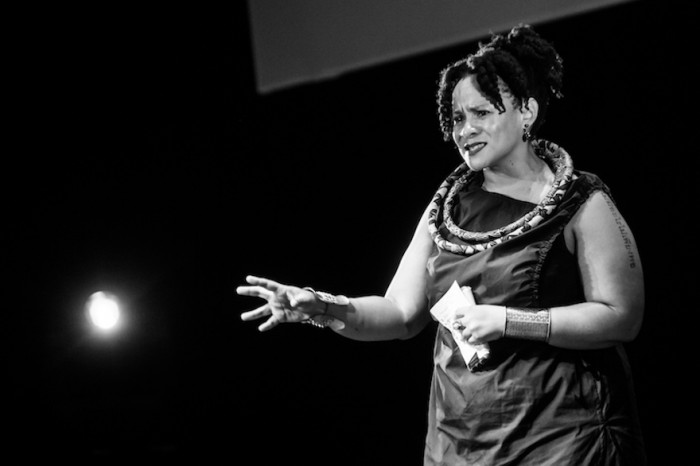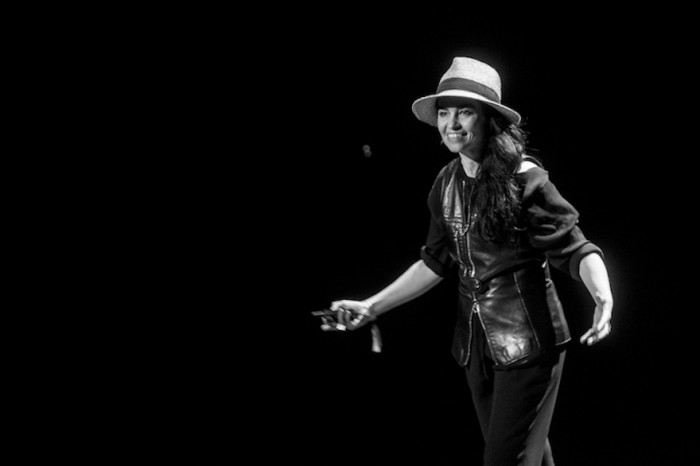From material ecology to architecture, the women at Design Indaba Festival 2018 brought with them a buffet of new ideas, fresh perspectives and startling innovations. Here’s a rundown of some of what you might have missed if you didn’t attend the Conference at the Artscape Theatre in Cape Town this month.
Lebo Mashile, the renowned South African performance artist, not only MC’d the event alongside fellow performer Buhle Ngaba, but also presented a series of poems on gender, race and identity as part of her Design Talk. Her words, powerful in her delivery, brought the house to tears, leaving the audience reeling.
It ended with a rousing performance from vocalist Ann Masina. The two performed a snippet of their play, Saartjie versus Venus, which debut at Nightscape at Design Indaba later that day.
From the power of theatre to the power of material, Neri Oxman took the stage to reveal some new work with MIT. Oxman is an American-Israeli designer and the founding director of The Mediated Matter Group at the MIT Media Lab.
She and her team create unique designs that live somewhere in the crossing between environmental design and high-tech morphogenesis (the way organisms develop their shapes).
Her work calls to attention a pressing question: What would it look like if we grew design rather than assemble?
A Global Graduate, Aleksandra Gosiewski is another designer who leans toward biological growth in her craft. To upend the pollution-heavy fashion industry, Gosiewski, the founder of AlgiKnit, is turning kelp into a yarn and further developing it into a textile.
She introduced one of their chief products at Design Indaba, an eco-friendly shoe that aims to revolutionise the manufacturing process.
Also in the realm of sustainable design, Lonny van Ryswyck introduced the audience to nuanced properties of sand. At Atelier NL, Netherlands-based designer van Ryswyck and her partner Nadine Sterk are finding a way to raise awareness around the swifty diminishing resource using ceramics.
Van Ryswyck and Sterk’s project, To See a World in a Grain of Sand, asks us to question what we’d do if we ran out of sand and what are we doing to preserve it.
South African-born Global Graduate and one of van Ryswyck’s former students Shaakira Jassat also took to the stage to talk about sustainability. Water is a scarce resource around the world and particularly scarce in Cape Town, which might become the first major city in the world to run completely out of water.
Her project, thirTEA for ONE shows the amount of virtual water that a simple cup of tea contains. For every 150 ml of tea, 30 litres of water is required in the entire chain process.
The installation functions as a large tea maker, where one has to pour water into the tallest cup continuously until the very last cup at the bottom is filled. As it stands today, it makes up for just one third of the 30 litres of water used in the production chain of a cup of tea.
The husband-and-wife founders of Studio Swine, believe it’s time we question how we could achieve harmony between nature and industry. Azusa Murakami presented their experiments with materials alongside husband Alexander Groves.
The designers are behind accessories made of human hair, furniture made from ocean waste, and cabinets made from aluminium foam.
Another husband and wife design duo, Ensamble Studio also took to the stage. The cross-functional team of architects Débora Mesa and Antón García-Abril presented their stunning architectural process in which they create mammoth structures that live within the landscape.
Mammoth structures made a physical appearance at Design Indaba this year with speaker Morag Myerscough. The British designer uses shapes and colour to affect mood and in doing so, creates an atmosphere that makes people feel as though they belong.
Myerscough both presented her work at Design Indaba and designed the creative playground at the Conference’s inner-city festival, Nightscape. Called Embrace the Unknown, the structure is an embodiment of Design Indaba’s aim, which is to be both cerebral and visceral.
Egyptian designer Amna Elshandaweely creates fashion collections that speak to identity, colourism and youth. Launching a new collection called Cairo Punk, Elshandaweely left the audience with the message that the youth are here to change the game.
Another young person hoping to change the game is Global Graduate Renata Souza, is interested in creating products that have a lasting impact on society and is concerned about the environmental impact stemming from her designs.
Her project, Thomy is a playful take on a serious condition. To help children with diabetes she created a insulin kit that includes a colourful insulin pen that she designed specifically for children and temporary tattoos that visually indicate where you've previously injected yourself.
Group design research director for Accenture Interactive’s Fjord Design and Innovation consultancy in Chicago, Martha Cotton has spent her life researching the way ordinary people interact with design. For her, human centred design thinking is at the forefront of her craft.
According to Cotton, design thinking is a way of behaving and in order for designers to create meaningful solutions, they must immerse themselves in the people they’re designing for.
A polar opposite to Cotton’s ethos, Pentagram partner and graphic designer Natasha Jen says design thinking is bullshit.
The Taipei-born designer believes that design thinking has become a lazy blanket term used by folks who don’t engage with creative work critically. She designed a one-of-a-kind poster for her presentation at Design Indaba.
The line-up of influential women ended with Es Devlin, a veteran in the industry. She’s designed stages for global icons like Kanye West, Adele and more. She walked the packed Artscape Theatre through her upbringing, influences and never-before seen sketches, which all make up her illustrious career.
While Design Indaba is proud of the gender balance within our speaker roster, it’s true that there is still more work to do when it comes to representations across binaries, races and ethnicities. Check back for each Design Talk and Interview from Design Indaba Festival 2018.



















